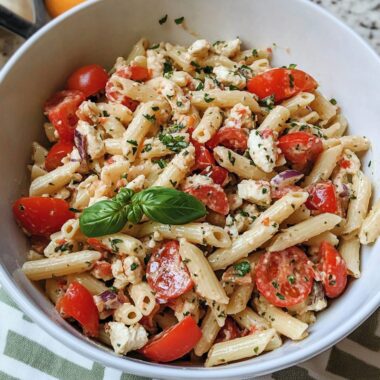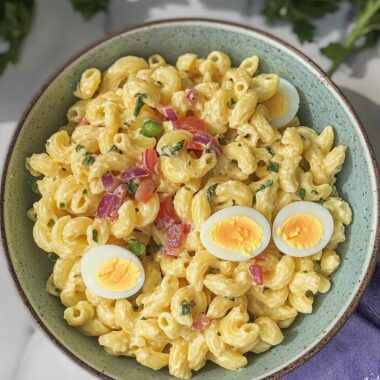Pepparkakor, also known as Swedish Ginger Cookies, are a delightful holiday tradition. These crispy, spice-filled cookies carry the warm flavors of ginger, cinnamon, and cloves, making them a festive treat that’s perfect for the cold season. Their delicate crunch and rich molasses flavor make them a favorite for both kids and adults during the Christmas season. Traditionally, these cookies are cut into fun shapes like hearts, stars, or animals, making them a fun and interactive holiday baking project. These cookies are not only delicious but also versatile. You can decorate them with royal icing for an extra festive touch, or enjoy them plain alongside a cup of coffee or glögg, a traditional Swedish mulled wine. Their aromatic spices make them perfect for gift-giving or sharing at holiday gatherings. Whether you’re continuing a family tradition or starting a new one, Pepparkakor are sure to add a touch of Scandinavian warmth to your celebrations.
Full Recipe:
Ingredients:
- 2 1/4 cups all-purpose flour
- 1/2 teaspoon baking soda
- 1 tablespoon ground ginger
- 1 tablespoon ground cinnamon
- 1 teaspoon ground cloves
- 1/2 teaspoon ground cardamom
- 1/2 teaspoon salt
- 1/2 cup unsalted butter, softened
- 1/2 cup granulated sugar
- 1/2 cup brown sugar, packed
- 1/4 cup molasses
- 1 large egg
- 1 teaspoon vanilla extract
Directions:
- In a medium bowl, whisk together flour, baking soda, ginger, cinnamon, cloves, cardamom, and salt. Set aside.
- In a large bowl, beat together the butter, granulated sugar, and brown sugar until light and fluffy.
- Add the molasses, egg, and vanilla extract to the butter mixture, beating until well combined.
- Gradually add the dry ingredients to the wet mixture, mixing until just combined.
- Divide the dough into two, wrap in plastic, and refrigerate for at least 1 hour.
- Preheat oven to 350°F (175°C). Line baking sheets with parchment paper.
- Roll out the dough on a lightly floured surface to about 1/8 inch thickness.
- Cut into desired shapes using cookie cutters. Transfer to the prepared baking sheets.
- Bake for 8-10 minutes or until the edges are golden.
- Let the cookies cool on a wire rack before serving or decorating.
Prep Time: 20 minutes | Chill Time: 1 hour | Baking Time: 10 minutes | Total Time: 1 hour 30 minutes Kcal: 90 kcal per cookie | Servings: About 30 cookies
Swedish Pepparkakor: A Timeless Christmas Delight
Swedish Pepparkakor, also known as ginger cookies or ginger snaps, are one of the most iconic holiday treats in Swedish cuisine. These thin, crispy, spiced cookies are deeply embedded in the Christmas traditions of Sweden, and they bring with them the cozy warmth of the festive season. Whether served with coffee, mulled wine, or simply enjoyed as a snack, Pepparkakor embody the comforting and inviting spirit of Scandinavian winters. But these aren’t just any ginger cookies; they have a rich history and a unique place in Swedish culture that make them particularly special.
The History and Origins of Pepparkakor
The tradition of baking spiced cookies dates back centuries in Sweden, with Pepparkakor becoming a Christmas staple over time. The word “Pepparkakor” literally translates to “pepper cookies,” and though they don’t always contain pepper today, early versions of these cookies did include black pepper, alongside other warm spices like ginger, cinnamon, and cloves. These ingredients were once rare and expensive, making Pepparkakor a treat reserved for special occasions, particularly around Christmas.
The tradition of baking Pepparkakor is said to have originated in monasteries and royal courts during medieval times, where spices were valued for their preservative qualities and their ability to improve digestion. In fact, Pepparkakor were believed to have medicinal properties in the Middle Ages. Some even thought they had the power to improve mood, making them a popular gift among Swedish nobility and a sweet way to spread happiness during the long, dark winter months.
Cultural Significance and Traditions
In Sweden, Pepparkakor aren’t just cookies; they are a symbol of holiday cheer and family togetherness. Baking these cookies is often a multi-generational affair, with children, parents, and grandparents gathering in the kitchen to prepare batches of dough and cut them into festive shapes. Traditional Pepparkakor are often cut into hearts, stars, and animals, though more modern interpretations may include all sorts of shapes.
Pepparkakor are also closely associated with St. Lucia Day, a major holiday in Sweden celebrated on December 13th. During St. Lucia processions, girls dressed as Lucia (the saint of light) often hand out Pepparkakor to symbolize the warmth and brightness that the cookies—and the holiday itself—bring during the darkest time of the year. This custom further embeds Pepparkakor into the rich tapestry of Swedish holiday traditions.
One charming Swedish superstition related to Pepparkakor is that if you place a cookie in the palm of your hand and make a wish, you can crack the cookie by pressing in the center. If the cookie breaks into three pieces, your wish is said to come true. This small but meaningful tradition adds a layer of joy and magic to the already festive spirit of the season.
The Art of Baking Pepparkakor
While Pepparkakor may seem simple, they require a bit of care and technique to get just right. The dough must be chilled thoroughly before rolling out to ensure the cookies hold their shape, and it’s essential to roll them thinly for that signature crisp texture. The spices in the dough—ginger, cinnamon, cloves, and cardamom—are what give Pepparkakor their warm, aromatic flavor. Molasses or dark syrup provides a rich sweetness and a slight chewiness to the otherwise crisp cookies.
Another key aspect of Pepparkakor baking is the use of cookie cutters. Traditionally, Swedish families use special cookie cutters that have been passed down through generations. Hearts, stars, and animal shapes are the most popular, with the heart shape often symbolizing love and friendship. In many Swedish homes, the holiday season isn’t complete without a batch of intricately cut Pepparkakor displayed in decorative tins or hung on the Christmas tree.
Once baked, Pepparkakor can be enjoyed plain, but they are also often decorated with icing. This adds a festive touch, making them ideal for gift-giving or for hanging as ornaments. The thin, crisp texture of the cookie pairs wonderfully with the sweet, smooth icing, creating a balance of flavors and textures that delights both children and adults.
The Versatility of Pepparkakor
While Pepparkakor are traditionally enjoyed on their own, they can also be used in a variety of creative ways. One popular tradition is to use Pepparkakor in place of graham crackers for a Swedish-inspired cheesecake crust. The spices in the cookies add a delightful warmth to the creamy richness of the cheesecake, making it a perfect dessert for the holiday season.
Pepparkakor crumbs can also be sprinkled over ice cream, used in trifle desserts, or mixed into holiday granola for a festive twist. They even pair well with savory flavors, such as sharp cheeses, making them a versatile component of any holiday spread.
In Sweden, Pepparkakor are often served with coffee, tea, or glögg (a spiced mulled wine) during holiday gatherings. The cookies’ spicy notes complement the flavors of these beverages, making them an ideal treat for guests during Christmas parties or cozy evenings by the fire.
Health and Nutritional Benefits
Despite their indulgent flavor, Pepparkakor are relatively light compared to other holiday cookies. Since they are thin and crisp, they contain fewer calories than their more decadent counterparts, such as sugar cookies or shortbread. The spices used in Pepparkakor, particularly ginger and cinnamon, are also known for their health benefits. Ginger, for example, is known for its anti-inflammatory properties, while cinnamon is packed with antioxidants and can help regulate blood sugar levels.
Why Pepparkakor Should Be a Part of Your Holiday Tradition
The allure of Pepparkakor lies not just in their flavor but in the joy and tradition that come with making and sharing them. They are a reminder of simpler times when holiday baking was about bringing people together and creating cherished memories. Even today, the act of rolling out dough, cutting it into festive shapes, and watching the cookies bake to golden perfection in the oven remains a special experience for many families.
Incorporating Pepparkakor into your holiday traditions is a wonderful way to add a bit of Scandinavian charm to your celebrations. Whether you bake them with family, give them as gifts, or enjoy them with a hot cup of coffee on a cold winter’s day, Pepparkakor are sure to bring a sense of warmth and nostalgia to the season.
Conclusion:
Swedish Pepparkakor are more than just cookies they are a symbol of holiday warmth, tradition, and togetherness. Their spicy, aromatic flavor and crisp texture make them a delightful treat that can be enjoyed in a variety of ways, from simple snacks to festive decorations. With their rich history and deep cultural significance, Pepparkakor have earned their place as a beloved part of the Swedish Christmas experience.
As you celebrate the holidays this year, consider adding Pepparkakor to your baking repertoire. Not only are they a delicious and versatile cookie, but they also come with centuries of tradition and a sprinkle of holiday magic. Whether you are continuing a family tradition or starting a new one, Pepparkakor will surely become a cherished part of your festive celebrations for years to come.








